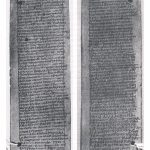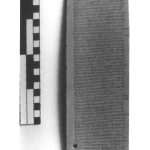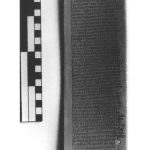| Artefact ID | 394 |
| TM ID | TM 64303 |
| Findspot (DEChriM ID) | 12 (Ismant al-Ḫarāb) | Class | Textual |
| Material | Wood |
| Writing medium | Tablet |
| Text content | Subliterary |
| Language | Greek |
| Description | P.Kell. II 98; T.Kellis 22; P.Kellis Gr. 98 A wooden, coated tablet containing the Manichean Prayer of the Emanations, which contains explicit mention of polytheism (see l. 15-17ff.). The board appears to be a repurposed codex-cover: the wooden board (approx. 30 x 9 cm, narrowing slightly at the top) has four holes for binding on its left side (two lower holes at l. 5-6 and 11-12, and two upper holes at l. 59-60 and 65). The scribe has written around the perforations, which indicates that the item has been repurposed. The coating indicates that is has been purposefully effaced before reuse. In the reference edition, Gardiner compares the format to P.Kell. III Gr. 95; see Gardiner 2007: 111. The title reads "Εὐχὴ τῶν προβολῶν" (Prayer of the Emanations) in l. 1, and the prayer ends with "ἐπληρώθη ἡ τῶν προβολῶν εὐχή" in l. 131-132 on the verso. Bermejo Rubio notes that "the emmenations" do not appear within the text beyond the title and end-title, and contends the possibility of a lithurgical function due to its relatively pristine condition; see 2009: 77. In the reference edition, the text is described as being of high quality, and the script being cursive and somewhat stylized; see Gardiner 2007: 112. A distant stylistic parallell can be found in Ms. 1 of P.Kell. III Gr. 95, which is arguably more cursive. Abbreviations and the usual nomina sacra can be found throughout the text, and punctuation is marked by right-slanting lines. The text contains a few errors and haplologies, and a nu has possibly been added as correction in l. 94. There have been some doubts concerning the Manichean affiliation of the text (see Khosroyev 2000: 360-386). Gardiner, however, argues that the Manichean claims are indeed substantialized inter alia by l. 70-77 that mention worship of 'the five great lights', which in the reference edition is interpreted to signify the Manichean ziwane against Khosroyev's planetary interpretation; see Gardiner 2007: 113. The text does not appear to be a translation from Syriac, and its Greek composition suggests that the text is not canonical. |
| Selection criteria | Literary genre (Non-canonical), Subliterary genre (Liturgical), Nomina sacra |
| Date from | 275 |
| Date to | 350 |
| Dating criteria | Palaeography, as well as archaeological and textual evidence. Bermejo Rubio (2009: 76) offers a terminus ante quem of 400 because of archaeological evidence, and suggests the first half of the 4th c. on account of palaeographical and contextual assesments. |
| Absolute/relative date | Relative date |
| Archaeological context | Find place: Egypt, Kellis 22 (31/420-D6-1/A/5 = P92.472), rear courtyard of house 3. Discovered in February 1992 in the backyard of “house 3” in Kellis (Ismant al-Ḫarāb) during an excavation directed by C.A. Hope for the Dakhleh Oasis Project (A.J. Mills). |
| Accession number | Current location unknown, probably excavation or SCA storage. P.Kell.Gr. 98 = Inv. no. 5336 = SCA no. 2084 |
ARTEFACT IDENTIFIERS
BIBLIOGRAPHY
Reference edition:
• Gardner, Ian, ed. with contributions by M. Choat, M. Franzmann, and K.A. Worp. 2007. Papyri from Kellis: The Kellis Literary Texts VI. Vol. 2. Dakhleh Oasis Project: Monograph 15. Oxford: Oxbow Books. 111-128 and plates no. 33-34.
Editio princeps:
• Jenkins, R. Geoffrey. 1995. "The Prayer of the Emanations in Greek from Kellis (
Additional bibliography:
• Bermejo Rubio, Fernando. 2009. "P. Kell. Gr. 98: un texto maniqueo del s. IV". Helmantica 6. 73-102.
• Bermejo Rubio, Fernando. 2009. "Further Remarks on the Manichaean Nature of ΕΥΧΗ ΤΩΝΠΡΟΒΟΛΩΝ (P. Kell. Gr. 98)". ZPE 168. 221-238.
• Khosroyev, Alexander. 2000. "Zu einem manichäischen (?) Gebet". Hyperboreus 7. 360-386.
Authors
Suggested citation
External links


 Json data
Json data





